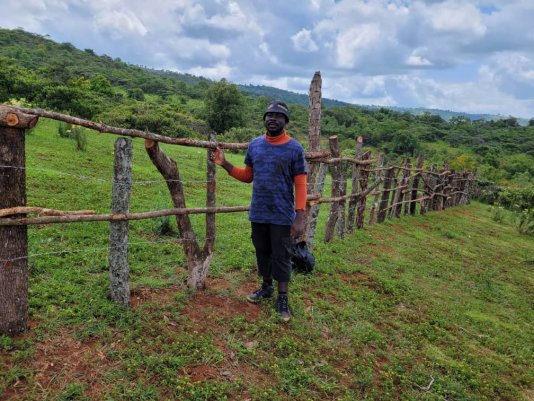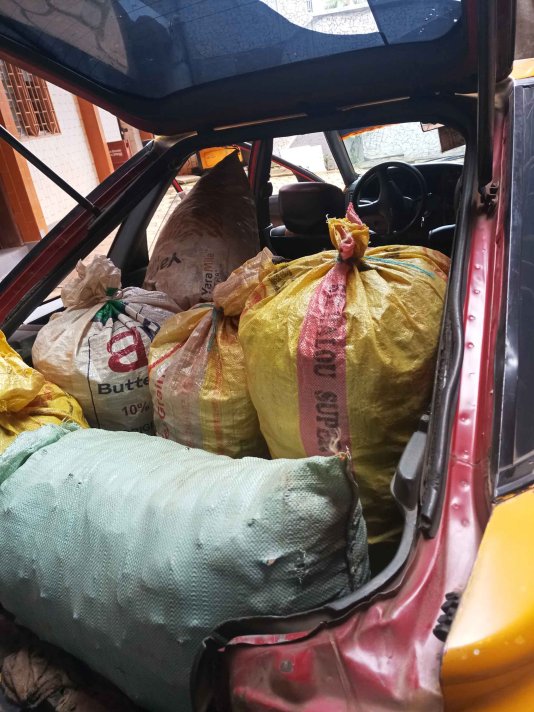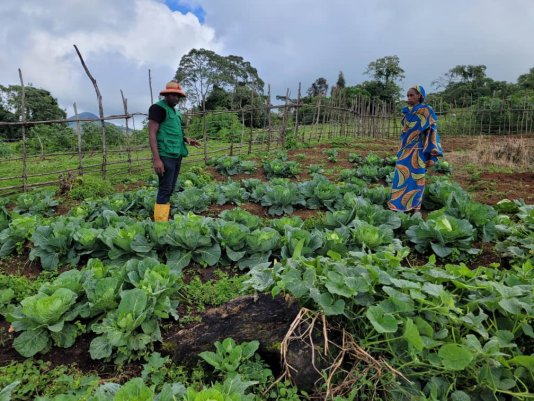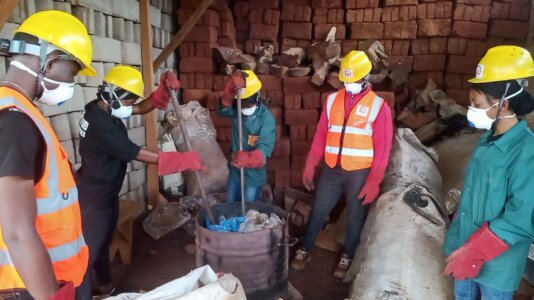- About
- Topics
- Picks
- Audio
- Story
- In-Depth
- Opinion
- News
- Donate
- Signup for our newsletterOur Editors' Best Picks.Send
Read, Debate: Engage.
| February 17, 2023 | |
|---|---|
| topic: | Conservation |
| tags: | #Cameroon, #biodiversity, #Africa, #animal hunting, #Sustainable Agriculture, #reforestation, #indigenous knowledge |
| located: | Cameroon |
| by: | Regobert Manigha |
Cameroon is home to one of Africa’s largest volcanoes, Mount Cameroon, located in its south-west region. The north of the central African country is a savannah: a semi-desert extending to Lake Chad. Its south is a lush tropical rainforest stretching from the north western boundary of the Congo basin and home to a variety of flora.
But conservationists and environmental activists from Cameroon fear the nation's natural treasures will see a sharp decline over the next decade if biodiversity conservation efforts are not stepped up.
Sunday Geoffrey, executive director of Support Humanity Cameroon (SUHUCAM), is concerned about a disappearing forest in Bamunkumbit village in the North West region of Cameroon.
"The areas earmarked for restoration in the Bamunkumbit Integrated Community Forest initiative were once biodiversity hotspots - hosts to species like chimpanzees, Baboons, monkeys and a lot more," Geoffrey told FairPlanet. "[But] years down the line, anthropogenic pressures, the cutting down of trees for agricultural purposes, bush fires, a growing population [and] climate change resulted in the degradation of this landscape."
The conservationist also blamed the disappearance of habitats, catchment areas and a decrease in soil fertility and agricultural productivity in Bamukumbit on the degradation of these landscapes.
"Bamukumbit used to produce many tons of maize per year in the early 70s, but figures have dropped significantly due to growing soil infertility," said Ibrahim Kela, a cattle breeder who testified that the threat posed by land degradation to the livelihood of smallholder farmers has triggered the recurrence of farmer-grazer conflicts, as cattle breeders and other farmers fight over remaining land plots and natural resources.
In 1994, the Cameroonian government enacted a comprehensive law number 94/01, which allows for greater collaboration between the government, local communities and NGO such as WWF to ensure to ensure sustainable forest management. "But the effective application of the law coupled with poor land use policies will lead us no where," said the executive director of the Ecosystems Awareness Fund, Nchimenyi Ndasi.
And while places like Bammukumbit and Bamboutos (in the West Region of the country) see their rich biodiversity disappear, illegal poaching remains a major threat to the existence of protected wildlife species in the country.
"To work in this conservation domain requires a positive mind-set; it is full of bad news," Eric Kaba Tah, deputy director of the Last Great Ape (LAGA), a local wildlife conservation organisation, told FairPlanet.
He added that there exists a national trade network in major primates, including mandrills, baby chimpanzees, baby drills and baboons due to the rising need for pets.
Cameroon has adhered to the six pillars of zero poaching introduced by the WWF, which seeks to effectively implement anti-poaching actions. This approach has helped the government involve local communities who struggle to save the country’s wildlife in protected areas through a community-based wildlife crime prevention framework.
But conservationists caution that if proper follow up is not carried out, concrete results will be difficult to achieve.
"The demand for pets has witnessed a steady rise in Cameroon for the past couple of decades, with rich people encouraging traffickers to supply them - especially with protected species - against the country’s wildlife law," Tah said.
The country's wildlife law lays forth modalities for the exploitation of forests, wildlife and fisheries in Cameroon, and allows for the fining or imprisonment of violators. The laws implementation, however, has been inconsistent, much to the chagrin of environmentalists.
In its 2016 forestry status potential figures, The African Forest Forum indicated that 29.8 million of Cameroon’s 46 million hectars of total land area is made up of degraded humid forests.
These stats are corroborated by Professor Thomas Smith, founder of the Yaounde-based Congo Basin Institute (CBI), who said that Cameroon is the richest biodiversity country among the six that make up the Congo Basin.
"Cameroon’s rich biodiversity is under serious threat given the country's rapid development in road construction, development of dams and the Kribi deep sea project," Smith said. "As we speak, the country's national parks and conservation areas only make up 11 percent of biodiversity, far less than the UN Global Biodiversity Framework "30x30."
Smith added that Cameroon needs to act quickly. "For the past 40 years, I have conducted research on the biodiversity of Africa’s rainforest and impacts of deforestation and climate change on biodiversity, [and] recent signs in Cameroon show persistent loss of biodiversity."
The biodiversity expert further stated that he is concerned "about the disappearing vertebrates, rainforest elephants and primates that can help to disperse at least 60 percent of different species of trees, which serve as habitat for different species of birds like doves - who in turn disperse 35 percent of the seeds of rainforest tree."
To this Los Angeles-based researcher, "there is no balance in the preservation of the natural resources for future generations compared to exploitation."
Smith's statements are corroborated by report on the IRAD survey published in September 2021, which estimates that at least two metric tons of wood from rare species-listed as critically endangered by the ICUN is being illegally removed from Ebo Forest in Cameroon each month.
These facts add to the observations of the World Wide Fund for Nature (WWF) on the attack on Cameroon’s ecosystem. Quoting WWF, the Cameroon Wildlife Conservation Society (CWCS) said that human activity is constraining the sustainable utilisation of the resources of the upper Nyong valley wetlands of Cameroon, considered one of the 200 global ecosystems in need of urgent conservation actions.
In the face of Cameroon's fast disappearing biodiversity, local initiatives, individuals and NGOs have been sprouting to rescue the country's natural treasures.
The Congo Basin Institute (CBI) is one of these NGOs. The organisation forges partnerships to address issues of food security, climate change, conservation and OneHealth with cross-cutting focus on capacity-building for locals in forested areas.
"Our 30 years of findings to understand the ecology of Cameroon - how animals move seeds and are important in rainforest restoration - have helped to take informed land management decisions, and in collaboration with the government, we have given guidance relating to the types of trees to grow in order to promote sustainable reforestation," founder Thomas Smith told FairPlanet.
"We have identified Tibati, Meiganga - and much of Ngaoundere in the Adamawa Region found between the rainforest and the savannah - as a zone that needs conservation works," he added. "They show the potential to generate and host adaptable biodiversity to withstand climate change in 50 years."
Four years ago, Thomas and his colleagues partnered with a group of Barka people in a long-term research study on the importance of seed dispersing animals to the maintenance of forests near the Dja biosphere reserve in southern Cameroon. He said that this research, conducted in collaboration with the school for indigenous knowledge and the local communities, have given the Barka people an immeasurable understanding of their role in protecting their forests and its resources.
"It helps them not to serve as aids in timber exploitation; to take up the challenge to check and report forest crime to competent authorities," said Smith, also adding that "Cameroon will have to plant many fruit trees that will accompany the indigenous populations if the country has to meet the 30x30 global biodiversity mark."
Meanwhile, Sunday Geofrey of SUHUCAM, along with his Bamukumbit Integrated Community Forest Initiative, have been working to develop their own holistic conservation approach.
"We have adopted nature-based solutions to our forest regeneration project," Geofrey said. "This consists in the provision of livelihood support in basic needs required for the cultivation of food crops which ensures food security in the area. This is an approach that incorporates socio-economic and environmental benefits in conservation."
The conservation advocate said that over 70 locals in Bamukumbit have benefited from the integrated forest project through the cultivation of fruits and vegetables from the regenerated land. "We give livelihood support in the form of inputs and farm equipment empowering especially the women to be financially independent."
"My mom has suddenly turned into a vegetable vendor, she sells cabbage in huge quantities harvested from the fenced area and this is helping to take care of six of us in the family," said 27-year-old Gibrila, the son of a cattle breeder-turned- vegetable farmer.
"With the collaboration of volunteers and cattle breeders, we have so far been able to plant and distribute [over] 19,000 indigenous tree species within the Bamunkumbit Integrated Community Forest site and to smallholder farmers within these communities - thanks to generous donations," Geoffrey said.
He emphasised that his choice for the types of trees to plant was deliberate. "Some of the tree species planted include medicinal, timber, fruits and fire resistant trees.
"While timber species have the potential to serve as carbon sinks in the future, medicinal and fruit trees will strengthen community resilience in order to adapt to climate change and enhance food security within the community."
Geoffrey leads the tree planting initiative in collaboration with indigenous populations through community dialogue.
"I have sold my cattle off in favour of the community project, which is restoring the cultivable land and other lost vegetation in Bamukumbit," said Ibrahim Kela, cattle farmer in Bamukumbit. "Since I can still possess cattle in the future, we would have regained enough land in this process to graze."
Georffrey said that in 2022 the project provided alternative livelihood support to 30 indigenous Mbororo women living around the Bamunkumbit Integrated Community Forest, organised capacity building events and provided farm tools and inputs to women engaged in organic vegetable cultivation as an alternative to cattle breeding.
"Besides the 19,000-plus trees planted, we have successfully established a solar powered nursery at the BICFOR site with over 20,000 tree seedlings, and fenced 15 hectares of the degraded forest earmarked for restoration," said Geoffrey.
He believes that the benefits of their actions for both nature and people have been the regenerated land, now a host to birds that are beginning to hatch thousands of insects, reproducing in favourable conditions and reviving the hope of recovering the area's lost biodiversity.
For their part, the Last Great Ape Organization (LAGA) has been cworking to strengthen the implementation of Cameroon's wildlife law.
"For the past 17 years, we have been helping the government to enforce Cameroon’s wildlife law, 750 wildlife traffickers have been arrested and prosecuted and 42 arrests were carried out only in 2022," said Tah.
He added that the success of their advocacy lies in the innovative approach they have introduced.
"We have stationed informants alongside undercover agents across the 10 regions of Cameroon. They feed us with tips, which we use to gather evidence against the traffickers, present to wildlife officers and state security operatives, collaborate right to arrest and help to draft and lodge complaints in competent offices.
"We do not relent in a criminal case on wildlife. We follow and push to ensure that the punishment equals the crime."
"We need to move from using artisanal tools to modern drillers in order to facilitate the tree planting process," said Geoffrey, "the soil is so hard to penetrate in the dry season and we are using local dig axes and shovels."
Government action in this case is led by the Bamukumbit Council, which has granted its approval for SUHUCAM to regenerate the area.
Geoffrey said that more support is needed from the government through representatives in parliament, since Cameroon is a decentralised state with numerous support funds sent to councils and MPs.
"Our expectation is still to yield. I look at the behaviour as some form of ignorance to our disappearing nature."
He added that with insufficient financing, raising funds isn’t any easy task, and that their efforts have been "brought down by a conflict-hit region, where funding institutions and the government pay greater attention to humanitarian and peace efforts."
Image by Regobert Manigha.
By copying the embed code below, you agree to adhere to our republishing guidelines.



